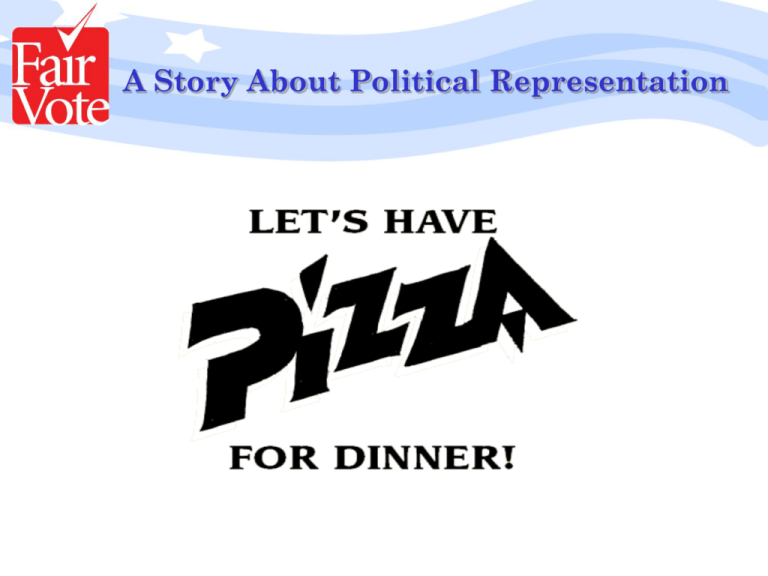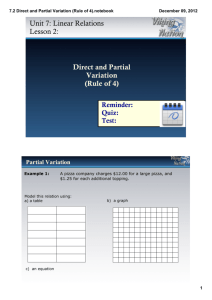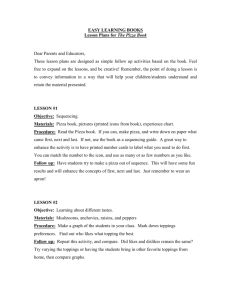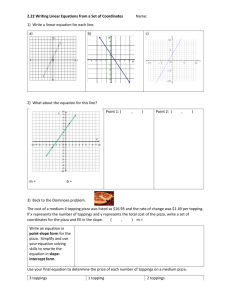A Story About Political Representation (choice voting and
advertisement

A Story About Political Representation Six Friends Want Pizza for Dinner Once, there was a group of six friends: an Alligator, a Bull, a Bear, a Cat, a Sheep and a Cormorant. They went out and ordered pizza for dinner. They decided to order one very large pizza and all split it. But what topping should they choose? They found that they could not agree on the topping, so they decided to vote to pick one. Everyone got one vote, and this is how they voted. Tallying the Pizza Topping Votes • • • • “Meat!” snapped the Alligator. “Meat!” growled the Bear. “Meat!” meowed the Cat. “Alfalfa!” cried the Bull and the Sheep in unison. • The cormorant thought hard – “Anchovies!” she finally squawked. The Winner-Take-All Result The animals thought only one topping could win– the highest vote-getter. So the three meat-eaters outvoted the vegetarians and the anchovy lover. The entire pizza would be topped with – Meat! This is called a winner-take-all election, because only the winners get their way, and everyone else is stuck. The Consequences of Winner-Take-All The Bull and Sheep, who didn’t get their choice at all, got huffy. “Not fair!” cried the Bull. “We’re vegetarians. We don’t eat meat.” “Sure it’s fair,” snapped the Alligator. “You were outvoted, fair and square. That’s how elections work, don’t you know?” “I’m leaving!” bleated the Sheep, who headed for the door. The Bull was not far behind. The anchovy-loving Cormorant was also upset at not getting her choice, but decided to stay and nibble on the discarded crusts. The Meat-Eaters and Vegetarians Disagree A Creative Solution… But before the Bull and the Sheep got out the door, the Bear, who was a fair-minded fellow, had an idea. “Wait! Don’t leave,” he said. “Maybe there’s a way we can all get what we want.” The Bear brought back the vegetarians, and they counted up the votes for each topping. The Alligator, the Bear, and the Cat all still voted for meat. The Bull decided he really wanted onions, and the Sheep stayed with alfalfa. And the Cormorant was still salivating over her choice, anchovies. Proportional Voting! So the animals asked the chef to prepare one very large pizza with the following toppings: •HALF of the pizza was topped with pepperoni; •ONE SIXTH was topped with onion; •ONE SIXTH was topped with alfalfa and •ONE SIXTH was topped with anchovies. Everyone got their FAIR SHARE of pizza, with their own topping. The six friends dug in, and a merry meal was had by all. This system is called PROPORTIONAL VOTING, because all voters win in proportion to their numbers. A Fair Result: Everyone Gets a Share of Pizza The Lesson of the Story: The Pizza Principle The voting system – not just the voters – determines who wins and who loses. And proportional voting systems are fairer than winnertake-all elections. In the first instance, everyone had to eat meat, even the vegetarians. That’s why this voting system is called winner-take-all, because only one topping can win – the one with the most votes. Everyone else loses. But in the second method everyone got their fair share. Everyone got the topping they wanted. It is called proportional voting because everyone is represented in proportion to their share of the vote. A History of Success Most of the world’s established democracies and some U.S. cities and private organizations use proportional voting systems for their elections because they provide the fairest results. Cambridge, MA has used a ranked choice proportional voting systems for over six decades. Illinois elected its state house through a proportional voting method for over 100 years, up until approximately 1980. Dozens of Alabama and Texas jurisdictions use proportional voting systems for local elections to ensure communities of color earn a fair share of representation. Putting Pizza Into Practice But how would we use proportional voting systems for actual elections? Imagine a thousand people are choosing a pizza. Everyone would get a ballot and pick their favorite topping. If 200 people checked onion, 20 percent of the pizza slices would be onion; if 500 people checked pepperoni, half of the pizza slices would be pepperoni; if 300 people checked sausage, 30 percent of the slices would have sausage. From Pizza to Politics Now replace pizza toppings with points of view (liberal, conservative, moderate, progressive) or political parties, and you’ve got an idea how proportional voting systems would work in elections. There are different election methods and ways to mark candidates, but the result is the same: voters win representation in proportion to their share of the vote. Now that’s fair!








